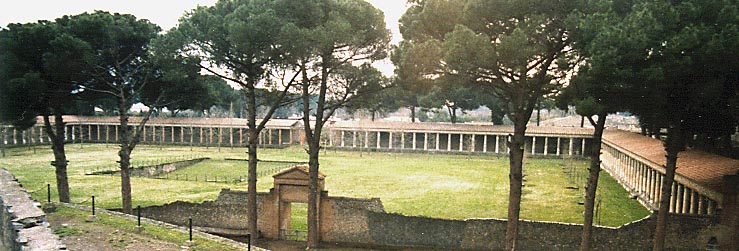Palaestra
![]()
Palaistra is a redirect to this article. For the mythical figure, see Palaistra (mythology).
The word Palästra (plural Palästren; ancient Greek παλαίστρα palaístra "wrestling ground", Latin palaestra) derives from the Greek Pale (πάλη "wrestling") and originally denoted an area covered with sand for the training of wrestling matches or for the corresponding competitions. Pugilism also took place here. Together with the dromos, the palaestra formed the Greek gymnasion.
In the 6th century B.C. the Palaestra was a purely athletic training facility with the function of securing military training, as with the Palaestra attested at Athens and Sikyon.
In the 5th century BC, the Palaestra became a humanistic educational institution where both physical and intellectual education took place. Architecturally, the palaestra transformed into a sophisticated complex: a large courtyard surrounded by columns (peristyle) with adjoining lounges and exercise rooms, of which Vitruvius mentions the following:
- ephebeum: changing room (originally of the ephebees); also: apodyterion.
- conisterium: wrestling practice room, "dust place", from Greek κόνις kónis, "dust".
- coryceum: training room for pugilists, from Greek κώρυκος kórykos, large leather sack filled with fig seeds, flour, and sand, which also served as a power tool.
- sphaeristerium: practice room for ball games, from Greek σφαῖρα sphaíra "ball, play ball".
- elaeothesium: massage and ointment room, also: ἀλειπτήριον aleiptérion, from ἄλειμμα áleimma "ointment".
Furthermore, there were already different bathing rooms (lutron) in the Greek palaestra.
Palaestra of this type are the Pompeion in Athens and the complexes in Epidauros, Olympia, Priene and Delos. Originally located rather on the periphery, the palaestra moved closer to the centre of the city (so in Corinth, Pergamon and Miletus) after it had become a public institution. Apodyteries and baths were financed by the state, but as an educational institution the palaestra remained the exclusive preserve of the upper classes until the imperial period.
The Romans eventually made the palaestra part of the complex of larger thermal baths. In Pompeii alone there were several complexes, e.g. the Great Palestra or the Palestra in the Stabian Baths. In addition to wrestling, there were also outdoor ball games (pila harpasta, pila paganica or pila follis, a kind of beach volleyball with different types of balls), ludere expulsim, a kind of tennis without a racket, where the ball is hit with the open hand, ludere datatim, similar to the Chinese fireball, and trigon: three players line up at the corners of a triangle painted on the floor and throw balls to each other without prior notice, which are to be hit back but not caught. Furthermore, there was strength training, also for women, with lead or stone weights in the form of dumbbells. Children practiced hoop driving.
The god of the Palaestra was Hermes, who was also cultically worshipped there (Hermaea).

Great palaestra (campus) in Pompeii
Questions and Answers
Q: What was a palaestra?
A: A palaestra was a building in ancient Greece where wrestling was taught and practiced.
Q: What did the courtyard of a palaestra look like?
A: The courtyard of a palaestra was typically large and rectangular, open to the sky, and surrounded by colonnades.
Q: What were some of the rooms located off the colonnades?
A: Off the colonnades in a palaestra were dressing rooms, lecture rooms, bath rooms, and rooms for storing equipment.
Q: How often did wrestlers practice at the palaestras?
A: Wrestlers practiced at the palaestras under the colonnades in all weathers.
Q: Were all cities in ancient Greece home to a palaestra?
A: Most cities in ancient Greece had at least one palaestra; larger cities may have had several.
Q: Who owned most of these buildings?
A: Most of these buildings were built with taxes rather than privately owned.
Q: How important was this building to Greek men and boys?
A: The Palaestra was very much part of everyday life for Greek men and boys; some even felt as much affection for their favorite Palaestra as modern men feel for their alma mater.
Search within the encyclopedia